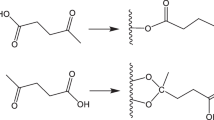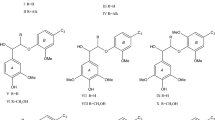Summary
The reaction of ferric chloride with the lignin model guaiacol affords primarily a complex mixture of coupled guaiacol oligomers. Major components were the symmetrical carbon-carbon coupled dimer 3,3′-dimethoxy-[1,1′-biphenyl]-4,4′diol and the trimer 3,3″,5′-trimethoxy-[1,1′:3′,1″-terphenyl]-4,4′,4″-triol which were isolated by preparative HPLC and characterized by 1HNMR spectroscopy and mass spectrometry. An unstable component believed to be a 4,4′-diphenoquinone derived from the trimer was also prominent. The reaction of chromium trioxide with guaiacol yields the same dimer, trimer and diphenoquinone as well as 2-methoxy-p-benzoquinone. The major product with chromium trioxide, however, is an inert, highly insoluble polymer which was shown by degradation to contain guaiacol oligomers bound or crosslinked by hydroxylated chromium species. Magnetic susceptibility measurements clearly indicated that the valency of chromium in the polymer was + 3. It is postulated that similar complexes formed from phenolic lignin units are responsible for the weather resistance of chromium trioxide treated wood surfaces. In a broader context this study is relevant to the fixation of hexavalent chromium from a range of widely used wood preservative formulations.
Similar content being viewed by others
References
Ashton, H. E. 1967: Clear finishes for exterior wood, field exposure tests. J. Paint Technol. 39: 212–224
Balogh, V.; Fétizon, M.; Golfier, M. 1971: Oxidations with silver carbonate/celite. V. Oxidations of phenols and related compounds. J. Org. Chem. 36: 1339–1341
Becker, H.-D. 1974: Quinones as oxidants and dehydrogenating agents. In: Patai, S. (Ed.): The chemistry of the quinonoid compounds Part 1., Chap. 7, pp. 335–423. London: Interscience
Boldt, P.; Michaelis, W.; Lackner, H.; Krebs, B. 1971: cis- und trans-3,3′-Dimethoxy-5,5′-di-tert.butyl-diphenochinon-(4,4′). Chem. Ber. 104: 220–227
Chang, S.-T.; Hon, D. N.-S.; Feist, W. C. 1982: Photodegradation and photoprotection of wood surfaces. Wood Fiber 14: 104–117
Crawford, R. L.; Robinson, L. E.; Foster, R. D. 1981: Polyguaiacol: a useful model polymer for lignin biodegradation research. Appl. Environ. Microbiol. 41: 1112–1116
Evans, P. D.; Michell, A. J.; Schmalzl, K. J. 1992: Studies of the degradation and protection of wood surfaces. Wood Sci. Technol. 26: 151–163
Evans, P. D.; Schmalzl, K. J. 1989: A quantitative weathering study of wood surfaces modified by chromium VI and iron III compounds Part 1. Loss in zero-span tensile strength and weight of thin wood veneers. Holzforschung 43: 289–292
Evans, P. D.; Schmalzl, K. J.; Michell, A. J. 1993: Rapid loss of lignin at wood surfaces during natural weathering. In: Kennedy, J. F.; Phillips, G. O.; Williams, P. A. (Eds.) Cellulosics: pulp, fibre and environmental aspects, pp. 335–340. Chichester: Ellis Horwood
Feist, W. C.; Hon, D. N.-S. 1984: Chemistry of weathering and protection. In: Rowell, R. M. (Ed.): The chemistry of solid wood. Chap. 11, pp. 401–451. Washington D. C.: Amer. Chem. Soc.
Feist, W. C. 1977: Finishing wood for exterior applications-paints, stains, and pretreatments. In: Goldstein, I. S. (Ed.): Wood technology: Chemical aspects, pp. 294–300. Washington D. C.: Amer. Chem. Soc.
Harrod, J. F.; Pathak, A. 1980: Reactions of some substituted phenols with chromyl and vanadyl chlorides. Can. J. Chem. 58: 686–693
Hewkin, D. J.; Griffith, W. P. 1966: Infrared spectra of binuclear complexes. J. Chem. Soc. (A): 472–475
Hon, D. N.-S.; Chang, S.-T. 1985: Photoprotection of wood surfaces by wood-ion complexes. Wood Fiber Sci. 17: 92–100
Kim, T.; Suzuki, Y.; Anazawa, I. 1980: Gravimetric determination of phenols. Bunseki Kagaku 29(9): 597–601
Kleinert, T. N. 1970: Physikalisch-chemische holzveränderungen im freien. Holzforschung und Holzverwertung 22(2): 21–24
Leigh, M. J.; Strickson, J. A. 1973: Oxidation of phenols with chromyl chloride. J. Chem. Soc. Perkin Trans. II: 1476–1479
Lindgren, B. O. 1960: Dehydrogenation of phenols II. Dehydrogenation polymers from guaiacol. Acta Chem. Scand. 14: 2089–2096
Michell, A. J. 1993: FTIR spectroscopic studies of the reactions of wood and of lignin model compounds with inorganic agents. Wood Sci. Technol. 27: 69–80
Mihailović, M. Lj.; Čeković, Z. 1971: Oxidation and reduction of phenols. In: Patai, S. (Ed.): The chemistry of the hydroxyl group Part 1., Chap. 10, pp. 505–592. London: Interscience
Miniutti, V. P. 1964: Preliminary observations. Microscale changes in cell structure at softwood surfaces during weathering. Forest Prod. J. 14(12): 571–576
Miniutti, V. P. 1967: Microscopic observations of ultraviolet irradiated and weathered softwood surfaces and clear coatings. U.S. Forest Service Research Paper, FPL 74
Musso, H. 1967: Phenol coupling. In: Taylor, W. I.; Battersby, A. R. (Eds.): Oxidative coupling of phenols. Chap. 1, pp. 1–94. New York: Marcel Dekker
Ohtani, K. 1987: Chromium trioxide enhances the durability of wooden doors. Chromium Rev. 8: 4–7
Pizzi, A. 1980: Wood waterproofing and lignin crosslinking by means of chromium trioxide/guajacyl units complexes. J. Appl. Polym. Sci. 25: 2547–2553
Pizzi, A. 1990: Chromium interactions in CCA/CCB wood preservatives Part II: Interactions with lignin. Holzforschung 44: 419–424
Simmons, K. E.; Minard, R. D.; Bollag, J.-M. 1988: Oxidative coupling and polymerization of guaiacol, a lignin derivative. Soil Sci. Soc. Am. J. 52: 1356–1360
Strickson, J. A.; Brooks, C. A. 1967: The oxidation of phenols with chromyl chloride-I. Phenol, chlorophenols and related phenoxytrichlorosilanes. Tetrahedron 23: 2817–2821
Strickson, J. A.; Leigh, M. 1968: The oxidation of phenols with chromyl chloride-II. 2,5-, 2,6- and 3,5-Dialkyl phenols. Tetrahedron 24: 5145–5149
Williams, R. S.; Feist, W. C. 1988: Performance of finishes on wood modified with chromium nitrate versus chromic acid. Forest Prod. J. 38 (11/12): 32–35
Williams, R. S.; Plantinga, P. L.; Feist, W. C. 1990: Photodegradation of wood affects paint adhesion. Forest Prod. J. 40(1): 45–49
Author information
Authors and Affiliations
Additional information
The authors wish to thank the following: Tom Syers (CSIRO Division of Forest Products) for technical assistance, Mary Reilly (CSIRO Division of Forest Products) for NMR spectral determinations and Ivan Vit (CSIRO Division of Chemicals and Polymers) for mass spectral determinations
Rights and permissions
About this article
Cite this article
Schmalzl, K.J., Forsyth, C.M. & Evans, P.D. The reaction of guaiacol with iron III and chromium VI compounds as a model for wood surface modification. Wood Sci.Technol. 29, 307–319 (1995). https://doi.org/10.1007/BF00202090
Received:
Issue Date:
DOI: https://doi.org/10.1007/BF00202090




